|
|
Post by Deleted on Jun 30, 2020 9:28:44 GMT -5
I’m a lurker rather than a member, but I do check in on He-Man.org at times. There’s a thread making a case for He-Man being derivative of Captain Marvel, not only for the obvious reasons, but because of the fact both Marvel and He-Man are acquainted with talking tigers!
It’s worth visiting the forum and reading it, although I have only read a few replies so far.
|
|
|
|
Post by Deleted on Jun 30, 2020 12:59:47 GMT -5
Deep breath... Transformers was a rebranding of two moderately successful Japanese toy line: Diaclone and Micro-Change. Micro-Change was an off-shoot of the Micro Man series, featuring transforming robots to compliment the robot figure toy line. Diaclone was also a spiritual successor to Micro Man. The toy designer wanted to build bigger, more elaborate giant robot mechas, and could only do so by shrinking down the scale of the robot figures that were the basis of the series. Thus Diaclone was created. It also explains why the size scale of the original Transformers is so whacky -- lord help him the guy driving Optimus Prime if he decides to go out for a jog while trying to carry Soundwave along or shoot Megatron at the range. Micro Man was a spiritual successor to Henshin Cyborg. The toy designer wanted to build bigger, more elaborate playsets, and could only do so by shrinking down the scale of the robot figures that were the basis of the series. To review so far: Henshin Cyborg was shrunken down to make Micro Man. Micro Man was shrunk down to make Diaclone. Henshin Cyborg was a spiritual successor to Combat Joe, a Japanese version of G.I. Joe. Henshin Cyborg added transparent, cyborg components to the Combat Joe figure. Combat Joe was the Japanese version of G.I. Joe. G.I. Joe was created in response to young boys wanting a socially acceptable Barbie doll. Yes. The Transformers are essentially a spiritual successor to Barbie. You're welcome. They were also part of the line that Mego licensed and brought to the US as Micronauts, and Mego just about had a deal in place to bring Transformers to the US when they went bust, and it was Marty Abrams of Mego who introduced the company to Hasbro to broker their deal. Had Mego not gone bust, Transformers would likely have been an extension of the Micronauts line in the US. -M |
|
|
|
Post by chaykinstevens on Jun 30, 2020 13:39:02 GMT -5
According to GCD, Dragon Lord in Marvel Spotlight v2 #5 was originally drawn as a Godzilla story, but the monster was altered slightly and the story revised when Marvel lost the rights to the character.
|
|
|
|
Post by dbutler69 on Jun 30, 2020 14:03:51 GMT -5
When Dave Cockrum left the Legion of Super-Heroes (because they wouldn't give him back his original art on the Bouncing Boy-Duo Damsel wedding) and went over to Marvel, some of the designs he'd planned to use on the Legion title became the All-New, All-Different X-Men, and some became the Sh'iar Imperial Guard. I know Nightcrawler in particular was one he'd basically designed when still working on the Legion, as well as several others.
|
|
|
|
Post by DubipR on Jun 30, 2020 14:40:30 GMT -5
Just watch "The Toys That Made Us" and all your questions will be answered..
|
|
|
|
Post by codystarbuck on Jun 30, 2020 20:38:44 GMT -5
rberman already brought up the Power Rangers, but to add to that a little, the Power Rangers in Japan were originally intended to be a Japanese version of The Avengers. Stan Lee had recently been to Japan and made an arrangement with Saban to produce a Japanese Spider-Man TV show many of you are already familiar with. The follow-up was going to be The Avengers, but (for reasons I'm not aware of) it became "Battle Fever J" instead, a series that laid the basis for the five person costumed team depicted in every Sentai/Power Rangers series since. Ehhhhhhhhhhhhhh............................. The Sentai series began in 1975, with Himitsu Sentai Gorangers, from Toei Studios, which was created to copy the formula of the Tatsunoku anime series Kagaku Ninjatai Gatchaman, aka Battle of the Planets, aka G-Force, Guardians of Space. The group copied the formula of 5 heroes, with themed costumes and weapons, operating as a secret task force of superheroes, against an alien menace. The series was followed by JAKQ Dengekitai, aka JAKQers, in 1977, where the theme of the costumes was playing card suits. That was followed by Battle Fever J, in 1979, where is was international themes. Marvel entered into an agreement with Toei to produce the Japanese Spider-Man series and licensed Toei to use the name Miss America for one of the Battle Fever J characters. It was the first series to use the term "super sentai," instead of just "sentai," and to feature them piloting giant robots, an idea carried over from Spider-Man. The series progressed with a new one, about every 2 years, much like Toei's other big superhero show, Kamen Rider. The version adapted by Saban, for broadcast in the US (Toei is the original Japanese studio, Saban was a production company who licensed the super sentai from Toei), was Kyoryu Sentai Zyuranger (or Juranger, for Jurassic, as it was dinosaur-themed). They almost went with the predecessor series, Chojin Sentaiu Jetman, which was a note for note copy of Gatchaman, with bird-themed costumes and mecha. Saban then used elements of the series that followed Zyurangers. Saban also combined Kamen Rider Black, Kamen Rider Black RX (the sequel to KR Black) and the movie Kamen Rider ZO, to create Saban's Masked Rider, which lasted for about a season, with the Power Rangers. They also combined footage from the "Space Sheriff" and "Metal Hero" shows (similar in concept to the super sentai; but with one or two characters, fighting monsters and criminals) to become VR Troopers. I think there was talk of doing something like the Avengers, but I don't recall that it morphed entirely into Battle Fever J. One piece of trivia: the super sentai series Kagaku Sentai Dynaman was adapted into a 6-episode parody, broadcast on USA Cable's Night Flight, as Dynaman, with some voicework from a couple of the Kids in the Hall gang... |
|
|
|
Post by codystarbuck on Jun 30, 2020 20:57:50 GMT -5
ps Saban wasn't the first to bring Kamen Rider to America, exactly. Because of the large Japanese-speaking population in Hawaii, several Japanese tokusatsu series were shown there, with at least English subtitles. One of the shows brought over was the second Kamen Rider series, Kamen Rider V3 (there were, eventually, two Kamen Rider heroes, in the original series, after the star suffered a broken leg and had to be replaced, for a time; then both heroes teamed up when he came back). Also show was Kikaider, about a heroic android. The Ultra series had been brought to the US and dubbed from the original Ultraman, and some of the sequel series (including Ultra 7) were syndicated in the US, or at least Hawaii and California. Then, Hana-Barbera created an animated Ultraman, in a pilot movie, though no further projects developed from it.
Giant Robo was shown here as Johnny Sokko, then a later anime series was released on home video. Also part of that wave was Space Giants, which was developed from the manga Ambassador Magma. You can also throw in Ogon Batto (Golden Bat), with Sonny Chiba, and Super Giant (aka Starman, ala Spaceman) which were serials that were dubbed for the US and edited together into movies.
Kamen Rider was a sort of successor to an earlier live action hero, Gekko Kamen, aka Moonlight Mask.
Sonny Chiba's character Hattori Hanzo, in Kill Bill, was another ancestor of a character by the same name he played in 5 series, known as Shadow Warriors, in the US and elsewhere (Known as Kage no Gundan, in Japan).
|
|
|
|
Post by codystarbuck on Jun 30, 2020 21:12:19 GMT -5
Here is the Battle Fever J team. 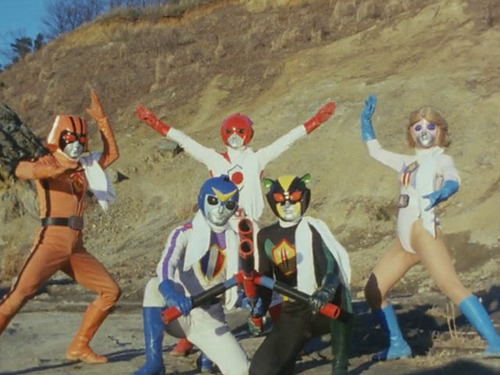 Miss America is the one without trousers. These are the ones who started it all.....  which led to this... 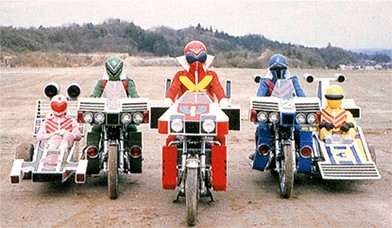 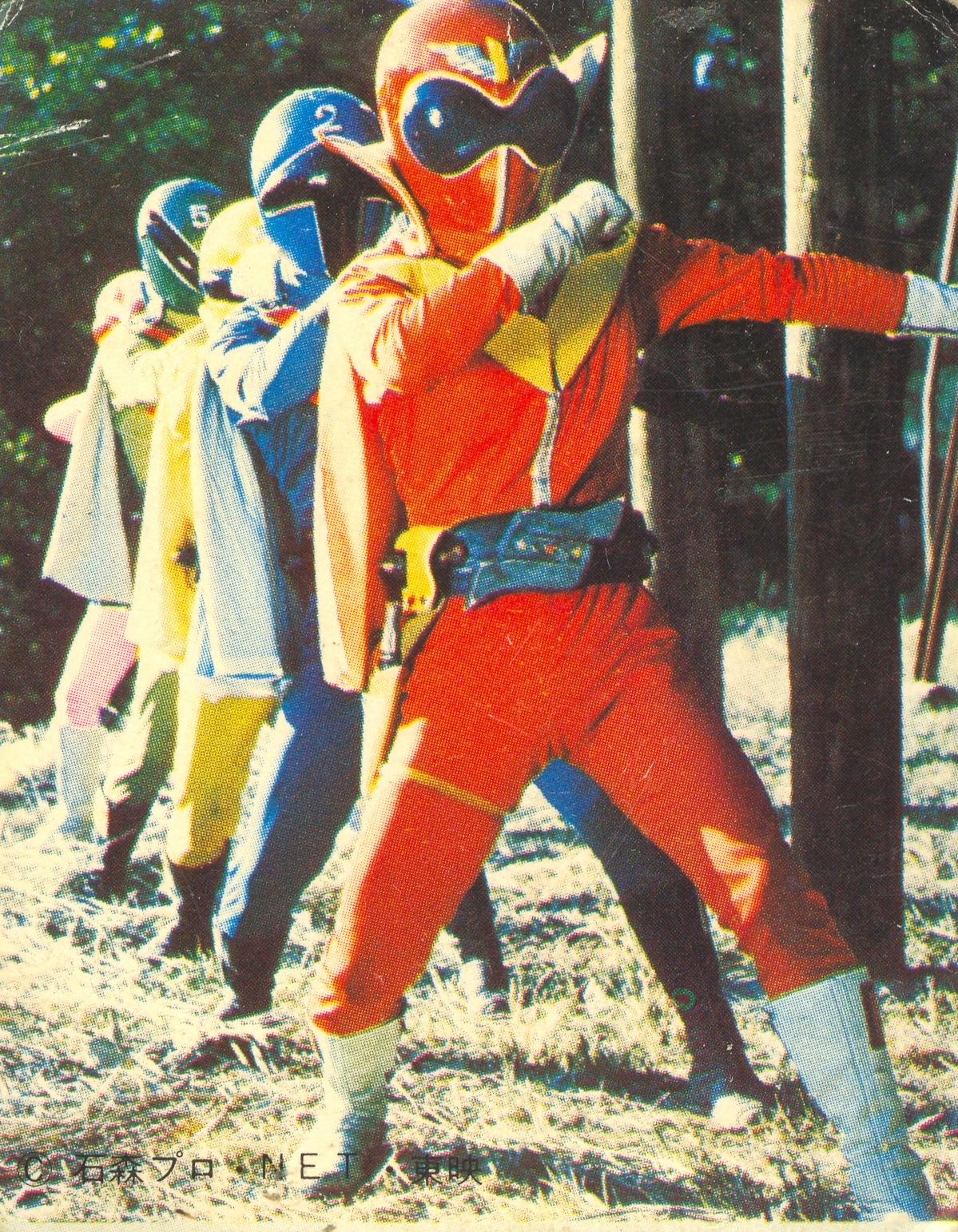 Here is Jetman... 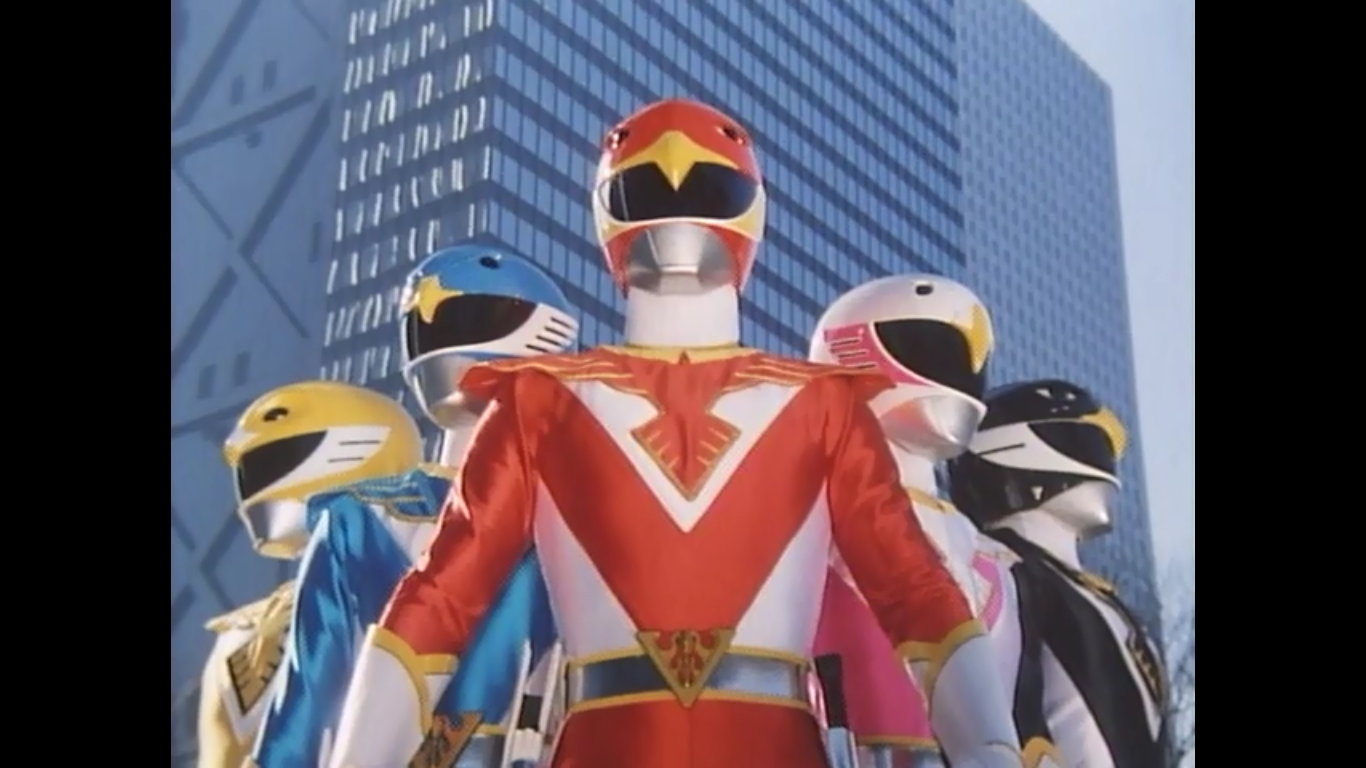 Kamen Rider V3... 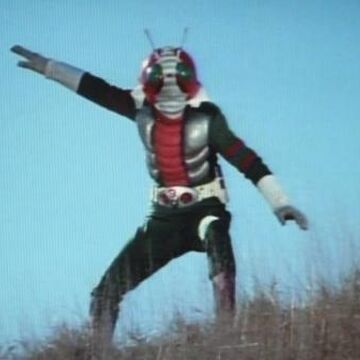 The Kamen Rider and Super Sentai costumes and stunt work would have a profound influence on Doug Rice's design for Mark Shaw's second Manhunter costume, after the Millennium event....  |
|
|
|
Post by rberman on Jun 30, 2020 22:16:53 GMT -5
What were the earliest hero squads that had varied powers, personalities, and multiple adventures? Jason and the Argonauts were more like the Avengers, a "Greatest Hits" temporarily assembling heroes who already had stories of their own. I can't think of any 19th century hero teams. Did they start with WW2 movies?
|
|
|
|
Post by codystarbuck on Jul 1, 2020 9:22:27 GMT -5
What were the earliest hero squads that had varied powers, personalities, and multiple adventures? Jason and the Argonauts were more like the Avengers, a "Greatest Hits" temporarily assembling heroes who already had stories of their own. I can't think of any 19th century hero teams. Did they start with WW2 movies? Doc Savage had his Famous Five, his team of assistants: Monk, Ham, Rennie, Long Tom, and Johnny, who debuted with Doc in 1933. You could point to the folkloric Robin Hood and his Merry Men, King Arthur & the Knights of the Round Table, Charlemagne and his Paladins. Jason & the Argonauts, the Greek heroes of the Iliad, among others. |
|